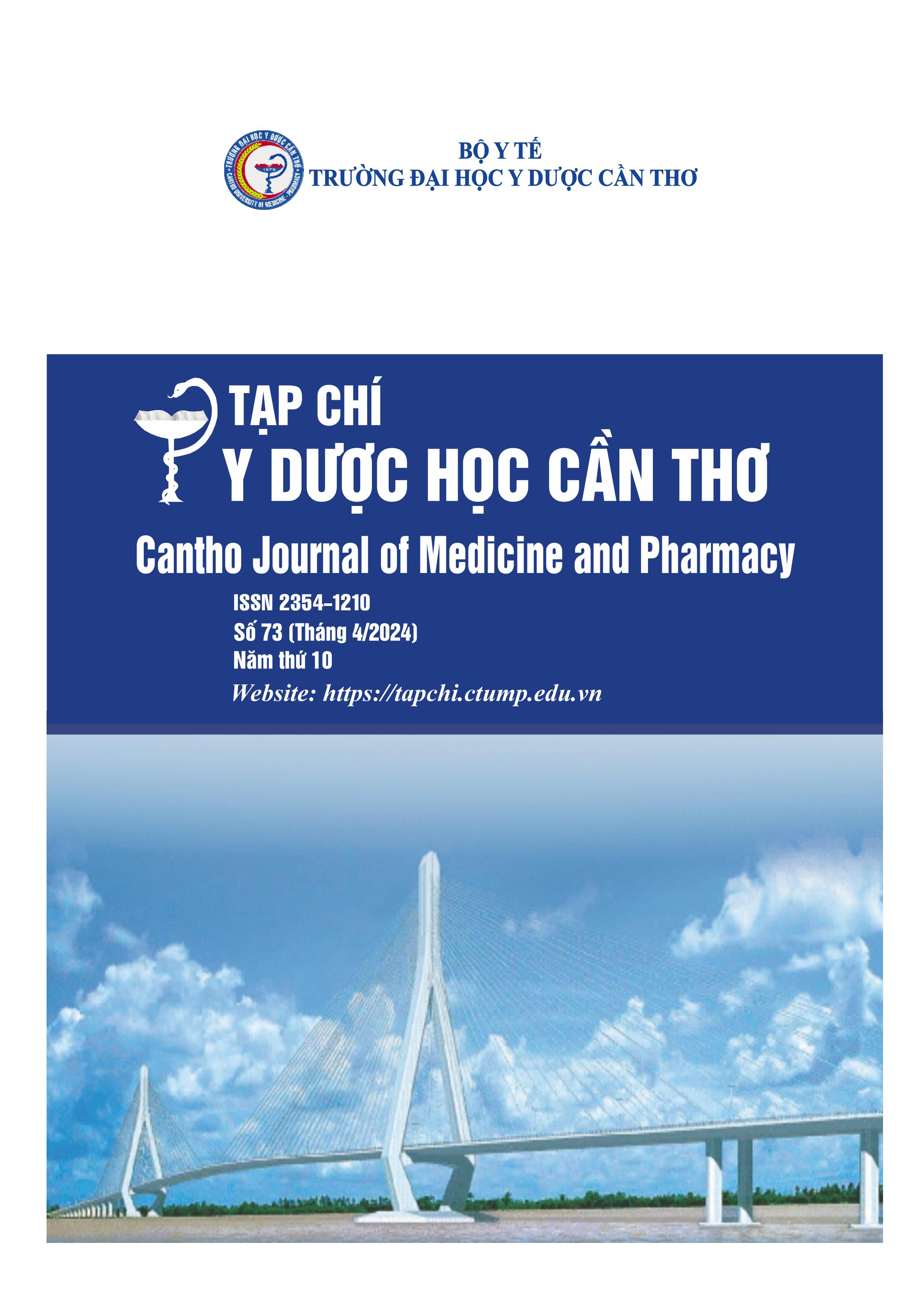NGHIÊN CỨU HOẠT TÍNH KHÁNG KHUẨN CỦA CAO CHIẾT VỎ THÂN CÂY LIM XẸT (Peltophorum pterocarpum (DC.) Backer ex K. Heyne)
Nội dung chính của bài viết
Tóm tắt
Đặt vấn đề: Ngày nay, vi khuẩn gây bệnh đề kháng với kháng sinh ngày càng phổ biến. Nhiều nghiên cứu cho thấy các hợp chất có hoạt tính sinh học có nguồn gốc từ thực vật có khả năng kháng khuẩn tốt với cơ chế phân tử đa dạng. Mục tiêu nghiên cứu: Khảo sát hoạt tính kháng khuẩn và định danh các hợp chất có hoạt tính sinh học từ cao chiết vỏ thân cây Lim xẹt (Peltophorum pterocarpum (DC.) Backer ex K. Heyne). Đối tượng và phương pháp nghiên cứu: Khảo sát khả năng kháng khuẩn của cao chiết vỏ thân cây Lim xẹt bằng phương pháp khuếch tán đĩa thạch và định danh các hợp chất có hoạt tính sinh học trong cao chiết bằng phân tích GC-MS. Kết quả: Khả năng kháng khuẩn của cao chiết ethanol 70% ở tất cả nghiệm thức là tốt hơn so với cao chiết ethanol 90%. Cao chiết ethanol 70% thể hiện hoạt tính kháng đối với 6 dòng vi sinh vật gây bệnh: Escherichia coli, Staphylococcus aureus, Aeromonas hydrophila, Dickeya dadantii, Vibrio parahaemolyticus và Candida albicans với đường kính kháng khuẩn tương ứng là 7,67 mm; 10,0 mm; 12,33 mm; 10,67 mm; 12,67 mm và 12,0 mm. Kết quả phân tích các hợp chất trong cao chiết P70 bằng kĩ thuật GC-MS xác định được sự có mặt của 5 hợp chất có hoạt tính sinh học gồm: 1phenylpropane-1,2-diol; methyl 4,6-dimethyl-3-nitro salicylate; benzoic acid, methyl ester (CAS) methyl benzoate; phosphonoacetic acid, dẫn xuất của 3TMS; hexadecanoic acid, methyl ester. Kết luận: Các hợp chất từ cao chiết vỏ thân cây Lim xẹt có hoạt tính kháng khuẩn đầy tiềm năng.
Chi tiết bài viết
Từ khóa
Cao chiết, GC-MS, Kháng khuẩn, Lim xẹt
Tài liệu tham khảo
2. Haruna and Yahaya. Recent advances in the chemistry of bioactive compounds from plants and soil microbes: A review. Chemistry Africa. 2021. 4, 231-248, doi: https://doi.org/10.1007/s42250-020-00213-9.
3. Muthukumaran P., Saraswathy N., Aswitha V., Balan and Gokhul V. B. Assessment of total phenolic, flavonoid, tannin content and phytochemical screening of leaf and flower extracts from Peltophorum pterocarpum (DC.) Backer ex K. Heyne: a comparative study. Pharmacognosy Journal. 2016. 8, 140-143, doi: 10.5530/pj.2016.2.7.
4. Nguyễn Nhật Thanh Phương, Trần Hồng Đức, Phạm Tấn Phương, Nguyễn Hoàng Trí Tài và Nguyễn Đức Độ. Khảo sát hàm lượng flavonoid, alkaloid và khả năng kháng khuẩn của cao chiết cỏ mần trầu (Eleusine indica). Tạp chí Khoa học Đại học Cần Thơ. 2017. 54-60, doi:
10.22144/ctu.jvn.2017.157.
5. Mohamad O. A., Li L., Ma J. B., Hatab S. and Xu L. Evaluation of the antimicrobial activity of endophytic bacterial populations from Chinese traditional medicinal plant licorice and
characterization of the bioactive secondary metabolites produced by Bacillus atrophaeus against Verticillium dahliae. Frontiers in Microbiology. 2018. 9, 924, doi: https://doi.org/10.3389/fmicb.2018.00924.
6. Abdelwahab S. I., Zaman F. Q., Mariod A. A., Yaacob M., Ahmed Abdelmageed et al. Chemical composition, antioxidant and antibacterial properties of the essential oils of Etlingera elatior and Cinnamomum pubescens Kochummen. Journal of the Science of Food Agriculture. 2010. 90, 2682-2688, doi: https://doi.org/10.1002/jsfa.4140.
7. Wu M. and Brown A. C. Applications of catechins in the treatment of bacterial infections. Pathogens. 2021. 10, 546, doi: https://doi.org/10.3390/pathogens10050546.
8. Alemdar A., Tan B., Toksöz O., Kurtuluş G., Sesal C. et al. Systematically investigation on the spectral, antioxidant and antibacterial properties of fragrant methyl benzoate esters containing electron withdrawing and electron releasing groups. Journal of Molecular Structure. 2023. 1291, 136100, doi: https://doi.org/10.1016/j.molstruc.2023.136100.
9. Freestone T. S., Ju K. S., Wang B. and Zhao H. Discovery of a phosphonoacetic acid derived natural product by pathway refactoring. ACS Synthetic Biology. 2017. 6, 217-223, doi: https://doi.org/10.1021/acssynbio.6b00299.
10. Onyegeme-Okerenta B. and Essien E. Analysis of bioactive compounds present in the leaf extracts of Senna alata, Dennettia tripetalla and Delonix regia. Asian J. Emerging Res. 2021. 3, 59-64, doi: https://doi.org/10.3923/ajerpk.2021.59.64.
11. Mostafiz M. M., Hassan E. and Lee K. Y. Methyl benzoate as a promising, environmentally safe insecticide: current status and future perspectives. Agriculture. 2022. 12, 378, doi: https://doi.org/10.3390/agriculture12030378.
12. Fajrih N., Wiryawan K. G., Sumiati S., Syahpura S. K. and Winarsih W. Identification of bioactive compounds of banana corm (Musa paradisiaca) using GC-MS and its inhibitory effect against pathogenic bacteria. Biodiversitas Journal of Biological Diversity. 2022. 23, 195-204, doi: https://doi.org/10.13057/biodiv/d230125.


